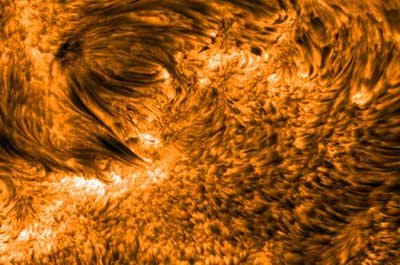It is customary to call this phenomenon "Spicules", which are actually jets of gas or plasma that are driven upwards from the lower atmosphere of the sun, and are shot into the upper atmosphere
The Institute for Advanced Technology in Palo Alto, translated by Alon Zeevi

In 1877, the scientific man for the first time discovered supersonic jets that erupt regularly from the sun, and since then the very reason for their existence has been a mystery. Today, a solar-physicist research group has managed to achieve impressive results regarding these jets, thanks to modern technology.
It is customary to call this phenomenon "Spicules", which are actually jets of gas or plasma driven upwards from the sun's lower atmosphere, the chromosphere. They are shot into the atmosphere or corona (solar halo) at a speed of about 80,450 km per hour, and reach a maximum height of 4,827 km above the surface in less than five minutes. At any given moment there are over 100 jets in the lower atmosphere of the Sun. And they still remain unexplained, mainly because it is difficult to observe objects with such a fast cycle (about 5 minutes) and relatively small dimensions (about 480 km in diameter).
Dr. Bart De Pontio, one of the leading researchers in the study and a solar physicist at the Lockheed Martin Solar and Astrophysics Laboratory (of the Center for Advanced Technology in Palo Alto, California), says: "It was extremely essential for the research, which tries to understand how the "Spicules", to cross-reference the information from the 2 main sources - 1) three space/solar telescopes that yielded valuable data and the highest resolution images ever: SOHO (Solar and Heliospheric Observatory satellite), which focused on the surface of the sun, The Swedish SST (Swedish Solar Telescope) and TRACE (Transition Region and Coronal Explorer satellite) which focused together on the jets in the sun's lower atmosphere; 2) Computer models that aim to provide the missing link between the various observations made by the telescopes".
Prof. Robertus Eardley van-Sibenburgen, another lead researcher and professor of applied mathematics at the University of Sheffield in the UK, says: "Thanks to a series of images taken simultaneously from both SST and TRACE, we found that the jets often occur cyclically, usually every About five minutes in the same area. We built a computer model that simulates the sun's atmosphere, to show that the periodicity of the "speckles" is caused by sound waves that are created on the surface of the sun and have the same activity cycle period of five minutes."
These sound waves, which are on the surface of the sun, in most cases weaken even before reaching the sun's atmosphere. On the other hand, the scientists De Pontio, Eardley and their student - Stuart James, found that under certain conditions the sound waves do manage to penetrate beyond the "Damping Zone" and leak into the atmosphere. According to the model we built, after the leakage of the sound waves, they become shock waves (Shock Waves) that push material upwards and thus create a jet/spicule.
De Pontio and his colleagues made practical measurements of waves and water points on the surface of the Sun, and fed the results they obtained into the computer model of the Sun's atmosphere. The scientists were pleasantly surprised when the model predicted with great accuracy the times of the appearance of the gas jets, thus enabling a focused observation of the sun with the help of SST and TRACE.
Their findings may lead to a deeper understanding of the question of how matter is pushed outward into the sun's halo to produce the solar wind - a stream of particles regularly distributed by the sun that drifts beyond the orbit of the sun. Disturbances in the solar wind, as already mentioned in the previous articles, may affect the upper atmosphere and space environment of the Earth, and even cause damage to the satellites orbiting the planet.
"The jets carry with them into the sun's atmosphere 100 times the amount of material required to "feed" the solar wind. This means that they are of utmost importance in the delicate balance between the material entering the sun's halo (the corona) and the material leaving it," De Pontio said. Along with revealing the origin of the 'speckles', it will be possible to investigate whether the mass they carry with them to the corona contributes to the solar wind. Future studies will also focus on the role that shock waves may play in the Sun's upper atmosphere or corona.
The research, the results of which were published in scientific journals, is funded by NASA - on behalf of the Particle Physics and Astronomy Research Council of UK, and by the Hungarian National Science Foundation.
--------
Translated by: Alon Zaevi, The Israeli Astronomical Society
